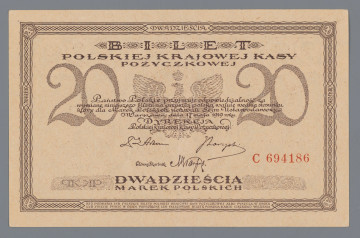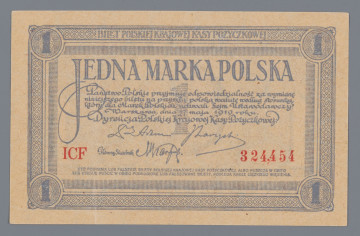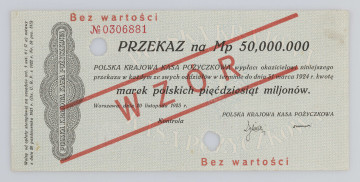
20 Polish marks
1919
National Museum in Lublin
Part of the collection: Paper money during the Second Polish Republic
It was a challenge for the Polish state reborn in 1918 to overcome problems related to the long functioning of the Polish lands within the structures of the partitioned states, which had different financial and monetary systems. After the end of World War I, Polish territories used not only the money of the partitioned states, but also Ukrainian banknotes and vouchers introduced by local entities. In the German-occupied part of the Kingdom of Poland (the Warsaw General Government), the occupier introduced Polish marks (mkp), issued by the Polish National Loan Fund (PKKP), from April 1917. Until the establishment of the Bank of Poland in 1924 and the introduction of national currency, the PKKP served as a banking institution, and the Polish mark remained a temporary currency. The Polish mark, which was gradually introduced into circulation throughout the country, gained the status of the exclusive currency in the former annexed territories: the German in November 1919, the Austrian in March 1920. The Russian ruble became a foreign currency in Poland in April 1920, and in the Eastern Borderlands in July 1921. In November 1922, the German mark became invalid in Upper Silesia.
While the graphic design of the first banknote of independent Poland with the face value of 500 mkp (issued on January 15, 1919) drew directly from the occupation patterns, the banknotes issued in May 1919 with the face values of 1, 5, 20, 100 and 1000 mkp are original works. Their author was an outstanding Polish graphic artist Adam Jerzy Półtawski (died in 1952), the creator of the Polish typeface (Półtawski's antique). What draws attention to them is the beautiful lettering and the aesthetic and uncluttered selection of graphic motifs. The obverse of this banknote features an image of Bartosz Głowacki, a symbol of a peasant fighting for Poland's independence, taken from Jan Matejko's painting Kościuszko pod Racławicami [Kościuszko at Racławice].
This banknote was used from 18 March 1920 to 1 July 1924. In March 1920 a little used men's coat lined with fur was offered for sale for 3,000 mkp, a nearly new men's autumn overcoat for 950 mkp, and a Warsaw boarding house on Jerozolimskie Avenue offered lunches from 16 mkp. A dollar in November 1918 cost 8 mkp, and in March 1920 already 156 mkp.
Tomasz Markiewicz
Author / creator
Dimensions
cały obiekt: height: 130 mm, width: 80 mm
Object type
paper money
Technique
Material
paper
Creation time / dating
Creation / finding place
Owner
The National Museum in Lublin
Identification number
Location / status

1919
National Museum in Lublin

1919
National Museum in Lublin

1923
National Museum in Lublin
DISCOVER this TOPIC
National Museum in Szczecin
DISCOVER this PATH
Educational path